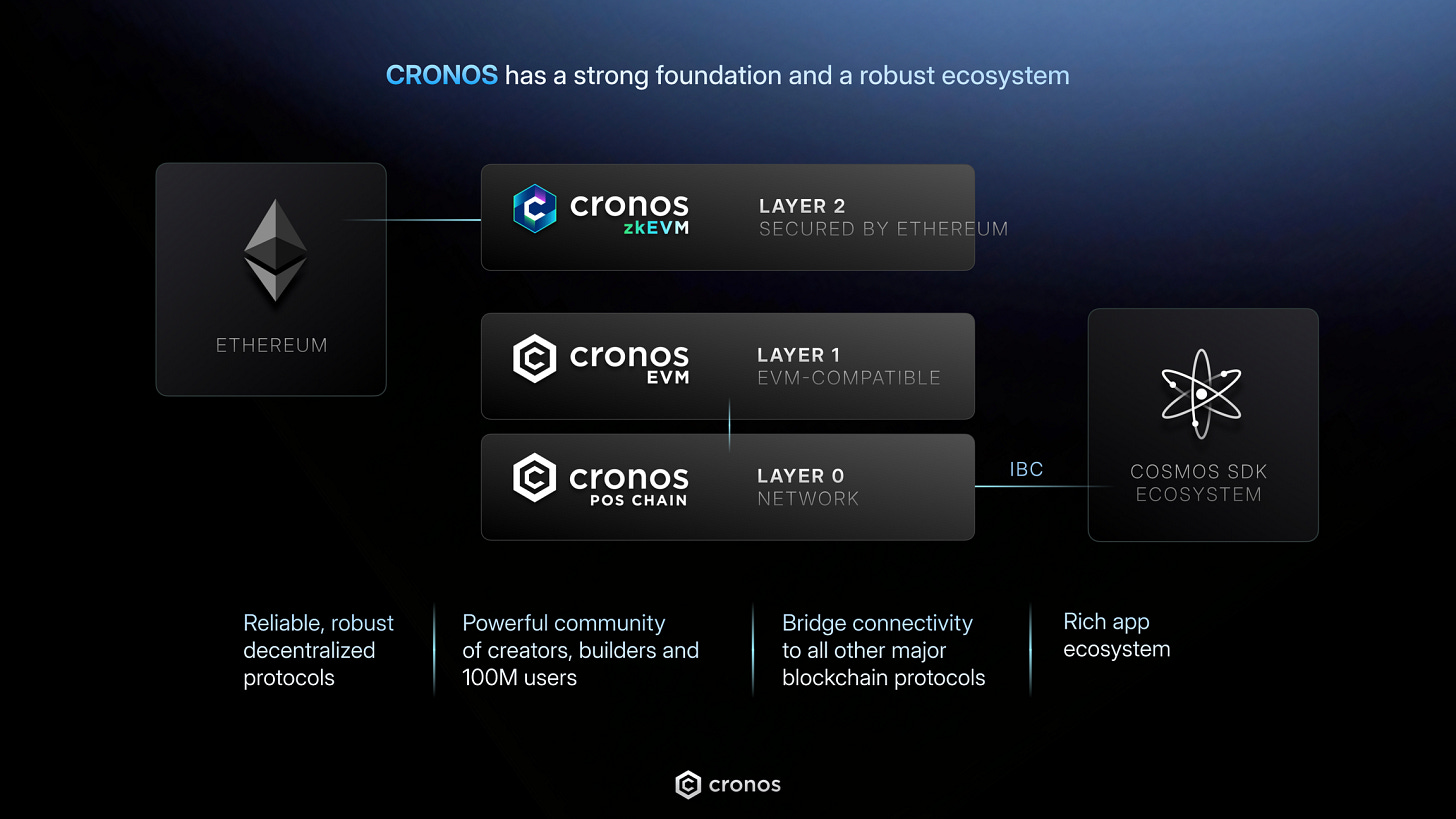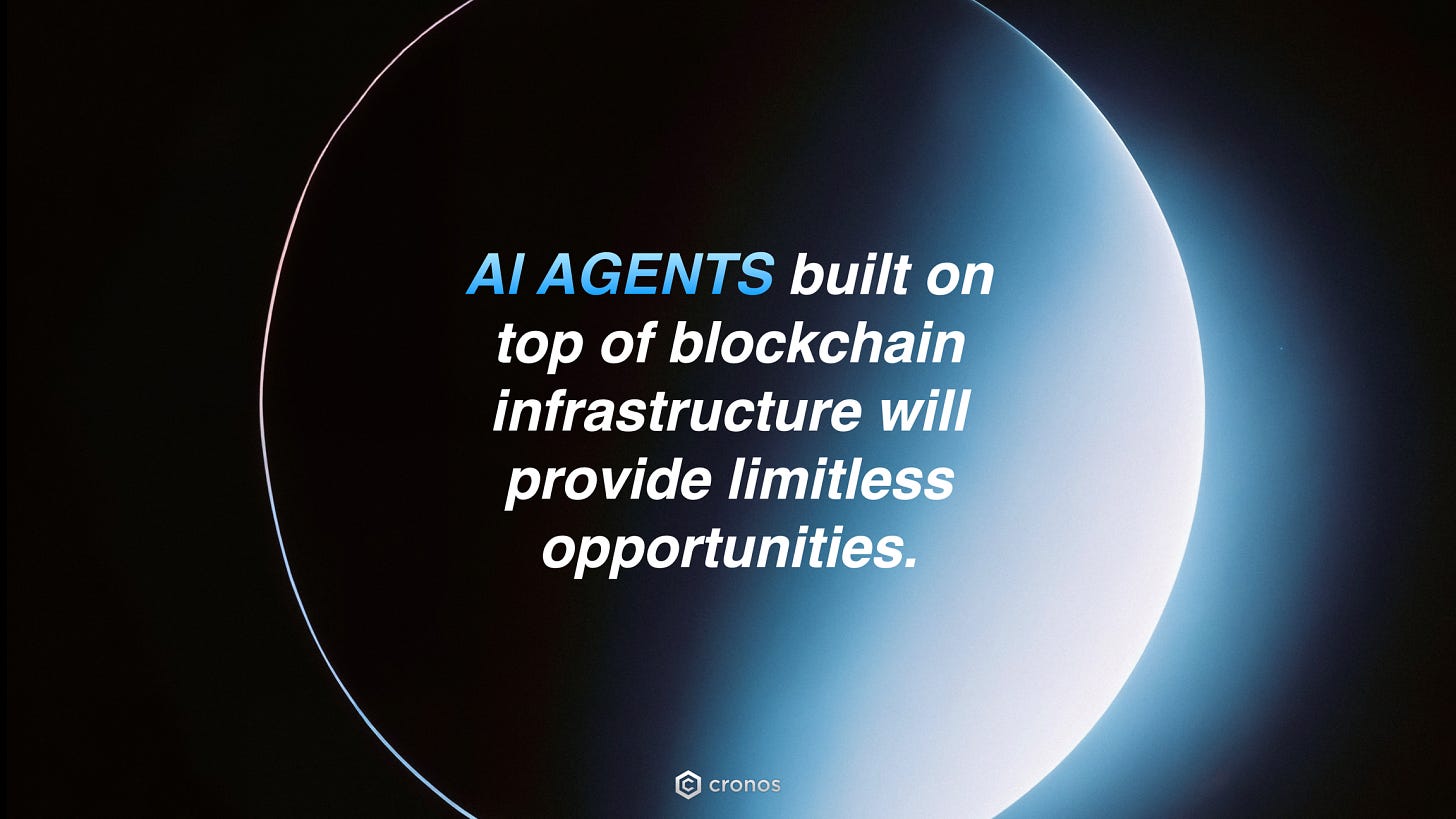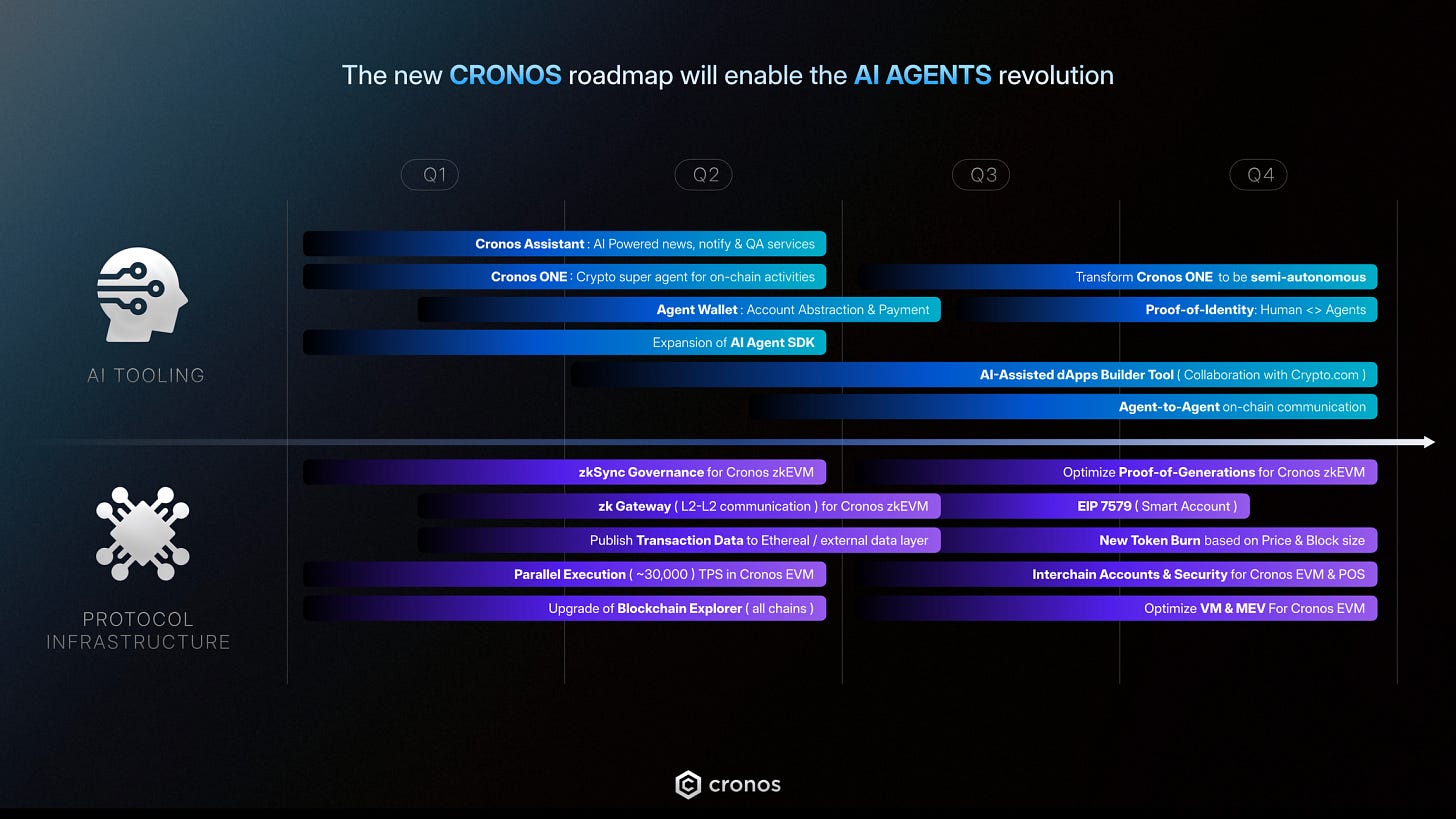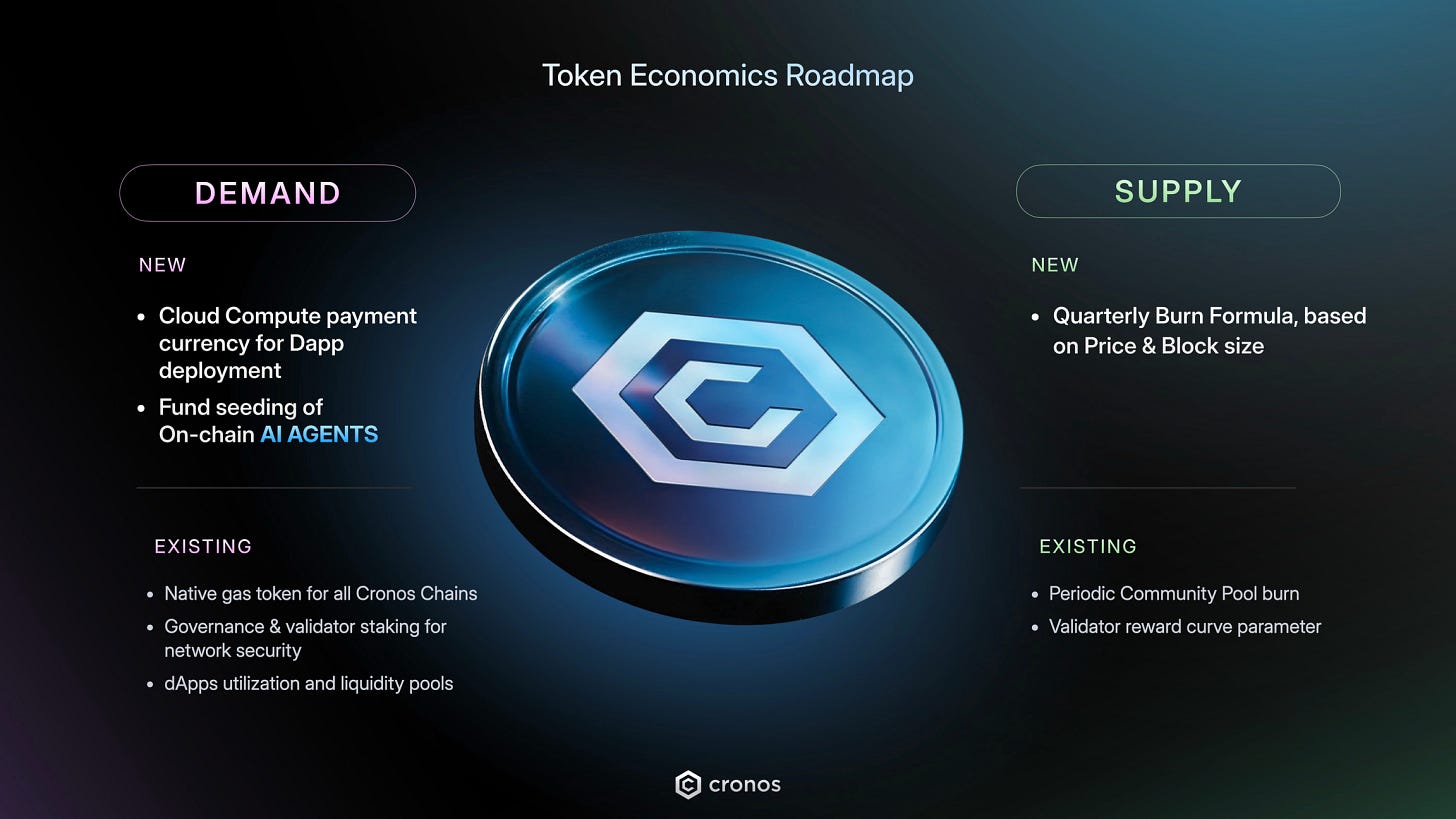Cronos Releases Comprehensive Roadmap Update for 2025 and Beyond in Documentation
Everything you need to know about the year 2025 Roadmap for Cronos EVM, Cronos zkEVM and Cronos POS
Key Takeaways
Launch of Cronos zkEVM has set the stage for a powerful, Ethereum-compatible layer 2, delivering scalability, gasless transactions, and zkCRO as a native gas token.
Renewed Developer Commitment with resources, infrastructure, and grants, aiming to attract leading Web3 builders.
Focus on AI and Decentralization to empower a billion AI agents, enabling decentralized applications and enhancing token utility across the ecosystem.
A New Era for Cronos: Roadmap Unveiled
The Cronos ecosystem is entering a new era of decentralized finance, blockchain technology, and artificial intelligence. As 2024 draws to a close, Cronos has released a detailed roadmap that reflects its commitment to scaling, interoperability, and enhanced developer support as it sets its sights on becoming the platform of choice for AI-powered decentralized applications.
State of Cronos in 2024
In 2024, Cronos launched the Cronos zkEVM network—a groundbreaking zero-knowledge (ZK) layer 2 solution secured by Ethereum. Built on ZKsync technology, Cronos zkEVM offers a scalable and gas-efficient framework, introducing zkCRO as its native yield-bearing gas token. This network already holds about $50 million of Ethereum-bridged funds and is a crucial part of the Cronos ecosystem, which now includes three chains:
Cronos zkEVM: Ethereum-compatible, zero-knowledge layer 2 focused on scalability and gasless transactions.
Cronos EVM: A programmable, Ethereum Virtual Machine (EVM)-compatible layer-1 chain built on Cosmos SDK, serving more than 500 decentralized applications and securing over $500 million in DeFi Total Value Locked (TVL).
Cronos POS: The foundational layer-zero network securing the ecosystem with around $1 billion in staked CRO and a transaction cost averaging $0.00001.
Each chain utilizes CRO, the native token governed by the Cronos POS chain, in distinct ways. For zkEVM, CRO serves as the basis for zkCRO gas tokens; in Cronos EVM and POS, it is the gas fee token that offers staking rewards and enables governance voting for decentralized decisions.
Major 2024 Developments Across Cronos Chains
Cronos zkEVM
2024 saw the release of the Cronos zkEVM mainnet in alpha, marking the beginning of a high-performance, gas-efficient layer 2 ecosystem. Notable advancements included:
Introduction of zkCRO, vETH, and vUSD—tokens that support the zkEVM DeFi ecosystem.
Launch of the Cronos zkEVM Pioneer Program, a loyalty initiative rewarding ecosystem contributors.
Development of account abstraction, ZKsync Elastic Chains integration, and cross-chain messaging with ZKsync ecosystem participants.
Cronos EVM
For Cronos EVM, 2024 was a year of technical improvements and integrations:
Performance enhancements yielded a 30% improvement in transaction processing, while memory and storage efficiency were significantly boosted.
IBC integration in the Cronos Explorer, alongside the implementation of CRC21 Standard, enhances interoperability within the Cosmos ecosystem.
Explorations into parallel and optimistic transaction executions, positioning Cronos EVM for increased throughput.
Cronos POS
In 2024, Cronos POS reached new heights:
Exceeded initial staking targets of 30% CRO to achieve a 60% goal, with nearly 40% of CRO now staked.
Ongoing research into liquid staking modules and efforts to strengthen the validator network.
Vision and Mission: The Future with AI
Cronos envisions a future where AI agents become central to blockchain applications. By 2025, Cronos aims to power an expansive network of semi-autonomous AI agents, capable of executing tasks, identifying trends, and creating new opportunities in DeFi, Web3 games, and decentralized data services. With Cronos’ infrastructure, these AI agents can conduct tasks ranging from analyzing social trends to organizing global events. AI integration will be prioritized across all three chains, allowing users and developers to create agent networks powered by blockchain.
2025 Roadmap Priorities by Chain
Cronos’ roadmap highlights unique priorities for each chain, supporting specialized use cases and ecosystem synergies:
Cronos zkEVM
Focus on AI-powered DeFi, trading, and cross-chain applications with integration to Ethereum. Active engagement in ZK Nation governance, exploring layer-2 progression to stage 1, and enabling seamless zkCRO utility.
Cronos EVM
Optimized for Web3 gaming and NFT applications, and advancing towards 30,000 TPS with parallel execution. Integration with Cosmos SDK updates will further enhance its scalability and usability for community-based projects.
Cronos POS
Expanding staking options, adopting Cosmos SDK’s interchain security, and enhancing the CRO token’s governance functions. The roadmap envisions further decentralization and support for Cosmos chain-compatible DeFi protocols.
Strategic Initiatives: AI, Token Economics, and Developer Support
Cronos will continue to strengthen its token economics by driving demand across all three chains while right-sizing token supply. Developer support will focus on enhancing tools and infrastructure, ensuring that the Cronos environment remains attractive to a growing developer community.
New AI and Developer Initiatives
Cronos’ focus for 2025 and beyond includes:
AI-Enabled Interfaces: Development of AI interfaces, such as “CRONOS ONE” portal and Crypto.com's AI Agent SDK, empowering developers and users to deploy, manage, and monetize decentralized applications with AI functionalities.
Developer Hub and Resources: The new cronos.org/build page consolidates resources, helping developers quickly access tools and start building.
Grant Program and Builders Program: New and improved financial incentives, milestone-based grants, and discounted developer tools to support innovative projects.
Infrastructure Partners and Marketing Partnerships
Cronos is collaborating with partners like Google Cloud, AWS, and Crypto.com to enhance its infrastructure. Additionally, marketing initiatives, including the Cronos Newsletter and conference sponsorships, will increase visibility for new applications in the ecosystem.
Token Economics Overview
The Cronos ecosystem has structured its token economics to ensure sustainable growth and reward mechanisms across all chains. Key aspects of token distribution and utility focus on supporting network security, staking, and incentivizing development.
Token Economics by Chain
Cronos zkEVM: The zkCRO token plays a pivotal role in the zkEVM chain’s economics, particularly through staking and governance. The ecosystem will enable staking among multiple validator nodes, adding a layer of decentralization and enhancing the network's security and resilience. zkCRO holders are incentivized to participate in protocol governance, allowing them to play an active role in decision-making and the prioritization of upgrades.
Cronos EVM: Cronos EVM leverages CRO tokens in its staking and validator operations, in alignment with the Cosmos SDK. The high throughput enabled by parallel execution on the EVM chain is designed to support a growing number of users and applications, potentially increasing demand for CRO tokens. Future interoperability with the Cronos POS chain will allow further distribution of value across the ecosystem.
Cronos POS: The POS chain emphasizes interchain security, staking, and validator participation, also utilizing CRO tokens. With upcoming enhancements in agent-to-agent protocols and on-chain commerce, there will be new opportunities for CRO token utility. The decentralized validator networks and agent-focused functionalities aim to attract broader participation, incentivizing token holders to engage with the ecosystem and fostering greater token circulation within Cronos POS.
Token Utility and Incentives
Across all chains, CRO tokens and related staking rewards are structured to support ecosystem security and encourage development. The integration of AI and decentralized governance, alongside improved staking mechanisms, positions Cronos tokens as integral to the network's long-term sustainability, allowing holders to benefit from staking rewards, governance participation, and potential value appreciation.
Cronos Chain Roadmap Overview (2024-2025)
Cronos has unveiled a detailed roadmap for each of its three core chains: Cronos zkEVM, Cronos EVM, and Cronos POS. Each chain has unique focuses and milestones, supporting specialized applications and advancing scalability, interoperability, and AI integration.
1. Cronos zkEVM Roadmap
Late 2024 to H1 2025
Core Protocol Enhancements:
Decentralized Governance: Operationalize ZKsync governance for more transparent protocol upgrades.
ZK Gateway Migration: Enable faster and more secure L2-to-L2 token transfers and cross-chain dApp functionality.
Transaction Cost Reduction: Implement proof aggregation across L2 chains and data publishing onto Ethereum or an external Data Availability Layer.
AI Capabilities:
Cronos Assistant: Launch an AI-driven news digest, notifications, and Q&A service.
CRONOS ONE: Develop a super agent for simplified access to a range of crypto dApps and use cases.
Advanced AI Features: Create specialized account abstraction and agent wallets, enhancing the Crypto.com AI Agent SDK for AI-centric applications.
H2 2025
Core Protocol Enhancements:
Proof Optimization: Server-level enhancements to further lower transaction costs.
Validator Networks: Transition to decentralized validator networks to enhance censorship resistance.
DeFi Expansion: Broaden the DeFi ecosystem with hyperchain connectivity, composability, and advanced cross-chain applications.
AI Capabilities:
Autonomous Agents: Develop Cronos ONE into an autonomous agent capable of completing user-assigned goals over time.
On-Chain Business Logic: New smart contract standards for escrow and limit order books tailored for AI-driven transactions.
Identity Protocols: Introduce identity protocols (e.g., proof of humanity) for agent interactions.
Bridge Connectivity:
Existing: Native Ethereum <> Cronos zkEVM, XY Finance, Rhino Finance.
Upcoming: 1 new third-party bridge to Solana; 2 additional bridges connecting to multiple EVM chains.
2. Cronos EVM Roadmap
Late 2024 to H1 2025
Core Protocol Enhancements:
Parallel Execution: Increase TPS to 30,000 through parallel transaction processing.
VM Optimization: Improve the virtual machine's performance for better efficiency.
AI Capabilities:
Gaming & NFTs: AI integration focused on Web3 gaming and NFTs, offering tools for developers targeting these sectors.
H2 2025
Core Protocol Enhancements:
Interchain Accounts & Security: Enable access to Cosmos SDK interchain accounts and interchain security.
EVM-POS Synergies: Explore interoperability and mutual enhancements with Cronos POS.
MEV Optimization: Address gas fee mechanisms with Maximum Extractable Value (MEV) improvements.
Bridge Connectivity:
Existing: Native IBC bridges, XY Finance, and Symbiosis.
Upcoming: 2 new bridges connecting to Cronos zkEVM and other EVM chains.
3. Cronos POS Roadmap
Late 2024 to H1 2025
Core Protocol Enhancements:
zkCRO Staking Distribution: Facilitate zkCRO staking across multiple validator nodes.
AI Capabilities:
Agent Transactions: Begin identifying necessary Cosmos SDK modules to support agent-to-agent transactions, laying the groundwork for on-chain AI collaborations.
H2 2025
Core Protocol Enhancements:
Interchain Accounts & Security: Expand access to interchain accounts and enhance security features.
EVM-POS Synergies: Foster deeper interoperability with Cronos EVM to unlock more ecosystem capabilities.
AI Capabilities:
Agent Collaboration: Introduce tools and protocols for on-chain agent commerce, including immutable communication records and escrow options.
B2B Agent Platform: Position Cronos POS as a B2B platform where AI agents can collaborate and outsource tasks.
Each chain's roadmap prioritizes both AI advancement and decentralized solutions, positioning Cronos as a forward-looking leader in blockchain interoperability, scalability, and AI-driven applications.
Conclusion
With the updated roadmap, Cronos is poised to drive innovation across blockchain and AI ecosystems. Its multi-chain approach, commitment to developer support, and pioneering work in AI-enabled decentralized applications position it as a leader in the Web3 landscape. As Cronos progresses through its roadmap, it aims to be the infrastructure backbone for a new generation of applications that make decentralized finance accessible and transformative for all users.
Source: Official Cronos Documentation








